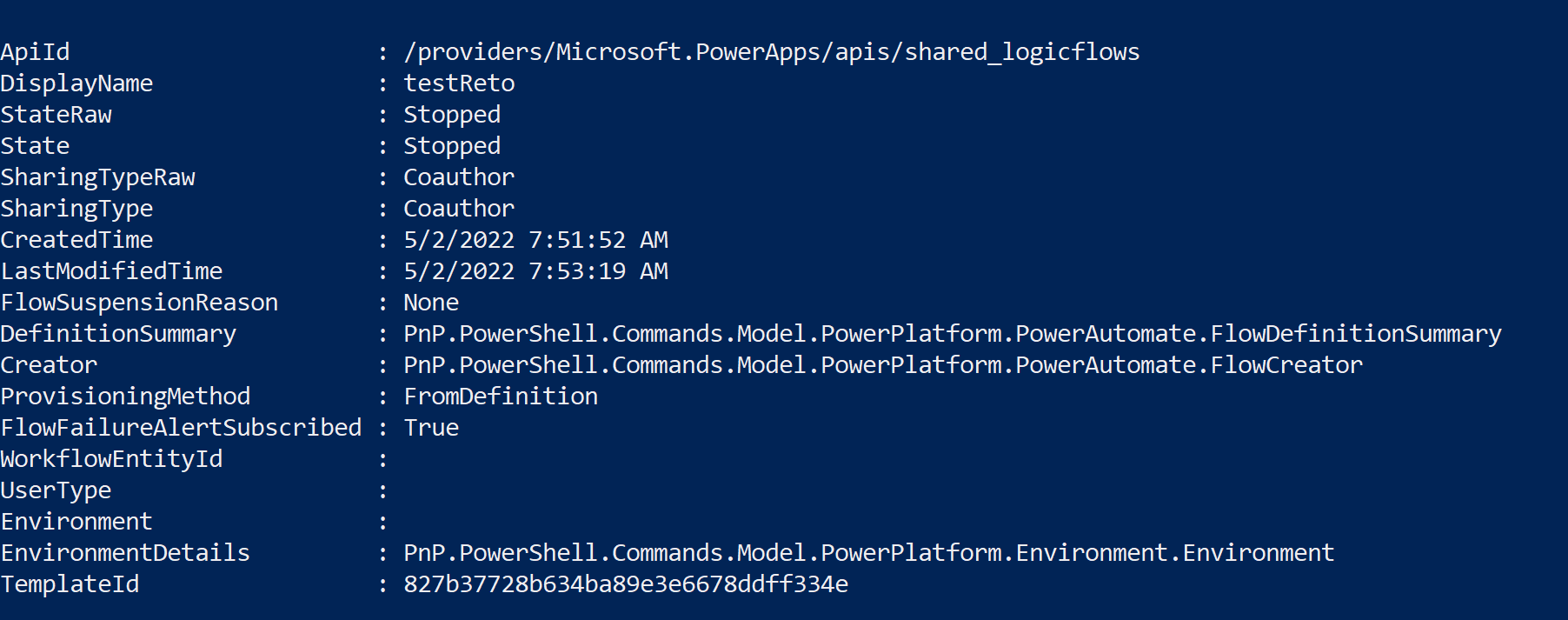Sharepoint Online: Manage your flows using PnP cmdlets
Introduction
Managing your flows using PnP is fabulously easy. Faster to code than CSOM, more options than classic SharePoint Online Management Shell.
Get
Get All Flows
$environment = Get-PnPPowerPlatformEnvironment
Get-PnPFlow -Environment $environment
Get Flows and their Properties
If you notice, the output from the previous cmdlet has a property called Properties. You can expand it to view more
Get-PnPFlow -Environment $environment | select -expandProperty Properties
ApiId : /providers/Microsoft.PowerApps/apis/shared_logicflows
DisplayName : Projekt archivieren
StateRaw : Started
State : Started
SharingTypeRaw :
SharingType :
CreatedTime : 4/12/2022 2:09:34 PM
LastModifiedTime : 4/12/2022 2:40:37 PM
FlowSuspensionReason :
DefinitionSummary : PnP.PowerShell.Commands.Model.PowerPlatform.PowerAutomate.FlowDefinitionSummary
Creator : PnP.PowerShell.Commands.Model.PowerPlatform.PowerAutomate.FlowCreator
ProvisioningMethod : FromDefinition
FlowFailureAlertSubscribed : True
WorkflowEntityId :
UserType : Owner
Environment :
EnvironmentDetails : PnP.PowerShell.Commands.Model.PowerPlatform.Environment.Environment
TemplateId :
Get Flow Actions
The same cmdlet allows you to see more details about the flow, like actions and creator details.
$props = Get-PnPFlow -Identity 5e904726-e098-41f4-a96a-066652abc113 -Environment $environment | select -ExpandProperty Properties
$props.DefinitionSummary.Actions
Type Kind SwaggerOperationId
---- ---- ------------------
OpenApiConnection HttpRequest
OpenApiConnection PatchItem
OpenApiConnection CreateNewFolder
InitializeVariable
OpenApiConnection CreateNewFolder
Wait
OpenApiConnection GetAllTables
Foreach
InitializeVariable
OpenApiConnection HttpRequest
InitializeVariable
Foreach
If
OpenApiConnection CreateNewFolder
SetVariable
Get Flow Creator Details
The Get-PnPFlow cmdlet allows you to see more details about the flow, like actions and creator details. Based on UserId you can identify who created the flow.
$props = Get-PnPFlow -Identity 5e904726-e098-41f4-a96a-066652abc113 -Environment $environment | select -ExpandProperty Properties
$props.Creator | fl
TenantId : 7f14efbc-9e1d-4f3f-99cd-01eccf994443
ObjectId : 6c1db2ba-f637-4f06-8b81-ba6e383b6aa1
UserId : 6c1db2ba-f637-4f06-8b81-ba6e383b6aa1
UserType : ActiveDirectory
Using the ObjectId you can retrieve the user from Azure Active Directory:
Get-MsolUser | where {$_.ObjectId -eq $props.Creator.ObjectId}
Get a list of flow authors
Using the same logic, you can check who creates flows in your environment
$flows = Get-PnPFlow -AsAdmin -Environment $environment | select -ExpandProperty Properties
foreach($flow in $flows){ Get-MsolUser | where {$_.ObjectId -eq $flow.Creator.ObjectId} }
Bonus
Have a look at these bonus scripts / solutions, and find out the most popular actions used in flows and the most frequent flow authors.
Power Automate: Get most frequently used actions
Power Automate: Get users who create most flows
Remove
You can remove unwanted flows using Remove-PnPFlow cmdlet.
Remove Single Flow
$environment = Get-PnPFlowEnvironment
Remove-PnPFlow -Environment $environment -Identity fba63225-baf9-4d76-86a1-1b42c917a182
Clean All Flows from the Environment
$environment = Get-PnPPowerPlatformEnvironment
$Flows = Get-PnPFlow -Environment $environment
foreach($flow in $flows){
Remove-PnPFlow -Environment $environment -Identity $flow.Id
}
Export
Using flow's name you can export it.
Export flow in JSON format to the console
$MyFlows = Get-PnPFlow -AsAdmin -Environment $environment
Export-PnPFlow -Environment $environment -Identity $MyFlows[1].Name
Export Flow as zip package
$MyFlows = Get-PnPFlow -AsAdmin -Environment $environment
Export-PnPFlow -Environment $environment -Identity $MyFlows[1].Name -AsZipPackage
Disable
If you disable a flow, it will change its State to Stopped
Disable-PnPFlow -Environment $environment -Identity 6301686e-5fe4-43fe-bef4-439a490ccf8f
Enable
If you enable a flow, it will change its State back to Started.
Enable-PnPFlow -Environment $environment -Identity 6301686e-5fe4-43fe-bef4-439a490ccf8f -AsAdmin








